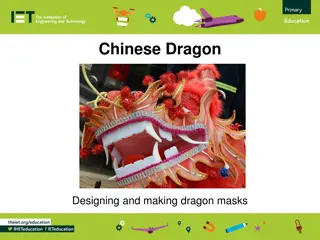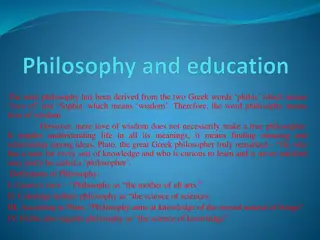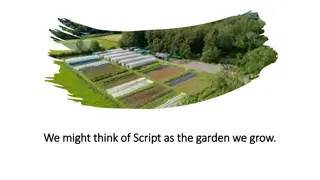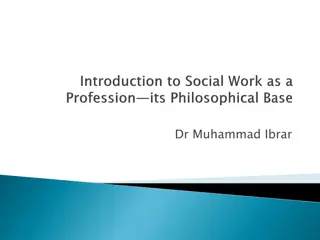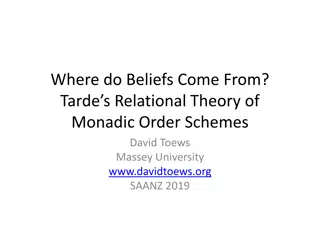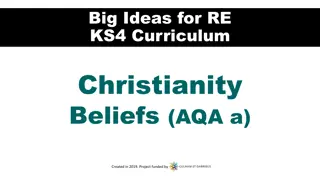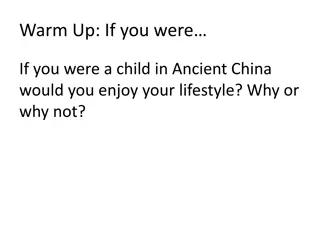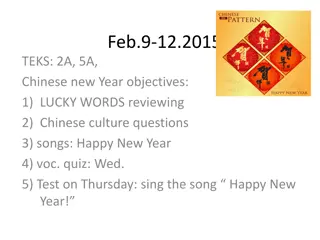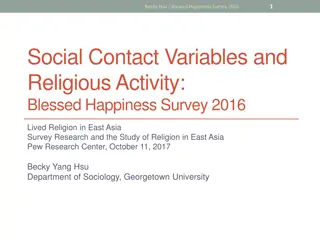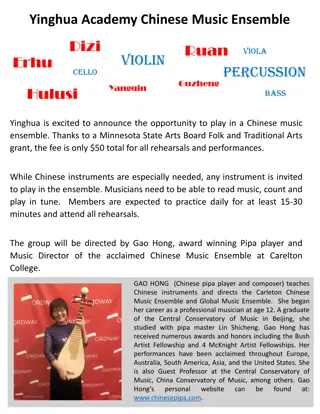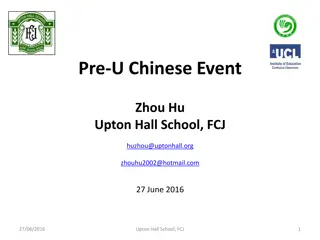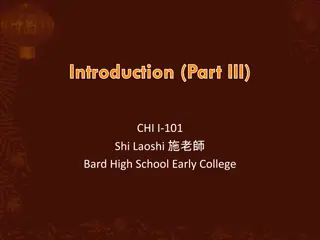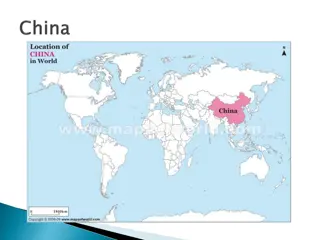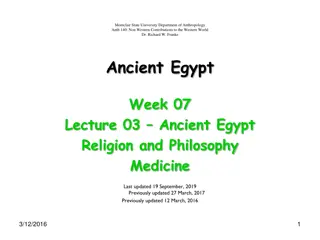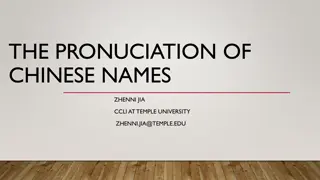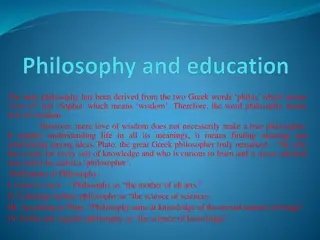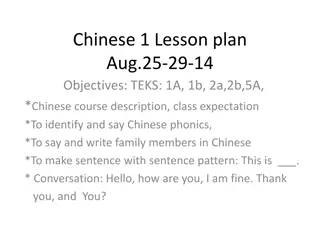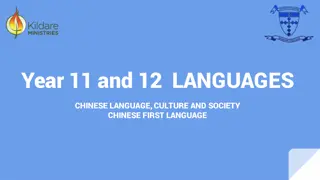Understanding Taoism: Ancient Chinese Philosophy and Beliefs
Taoism, an ancient tradition deeply rooted in Chinese customs, focuses on the concept of the Tao, the ultimate creative principle of the universe. It emphasizes harmony with nature, spiritual immortality, and self-development through practices like meditation and feng shui, while also incorporating the Yin and Yang philosophy. Despite its decline in popularity after the Communist revolution in China, Taoism remains a unique and profound philosophy guiding individuals towards living in alignment with the Tao.
Download Presentation

Please find below an Image/Link to download the presentation.
The content on the website is provided AS IS for your information and personal use only. It may not be sold, licensed, or shared on other websites without obtaining consent from the author. Download presentation by click this link. If you encounter any issues during the download, it is possible that the publisher has removed the file from their server.
E N D
Presentation Transcript
Taoism at a Glance Taoism is an ancient tradition of philosophy and religious belief that is deeply rooted in Chinese customs and worldview Taoism is also referred to as Daoism, which is a more accurate way of representing in English the sound of the Chinese word. Taoism is about the Tao. This is usually translated as the Way. But it's hard to say exactly what this means. The Tao is the ultimate creative principle of the universe. All things are unified and connected in the Tao.
Taoism at a Glance (continued) Taoism originated in China 2000 years ago It is a religion of unity and opposites; Yin and Yang. The principle of Yin Yang sees the world as filled with complementary forces action and non-action, light and dark, hot and cold, and so forth The Tao is not God and is not worshipped. Taoism includes many deities, that are worshipped in Taoist temples, they are part of the universe and depend, like everything, on the Tao Taoism promotes: achieving harmony or union with nature the pursuit of spiritual immortality being 'virtuous' (but not ostentatiously so) self-development Taoist practices include: meditation feng shui fortune telling reading and chanting of scriptures Before the Communist revolution fifty years ago, Taoism was one of the strongest religions in China. After a campaign to destroy non-Communist religion, however, the numbers significantly reduced, and it has become difficult to assess the statistical popularity of Taoism in the world.
What is the Tao? Many Taoist ideas come from other Chinese schools of thought. It's not always easy to draw accurate distinctions between ideas that are fundamentally Taoist and those that Taoism took in from elsewhere, especially Buddhism. The most important thing about the Tao is how it works in the world, and how human beings relate to it. Philosophical speculation about what the Tao actually is, is less important than living in sensitive response to the Tao.
The Tao is not a thing The Tao is not a thing or a substance in the conventional sense. It cannot be perceived but it can be observed in the things of the world. Although it gives rise to all being, it does not itself have being. Although it's conventional to refer to The Tao, some writers think that the "the" should be dropped because it isn't in the original Chinese term. They feel that using 'the' gives Westerners the idea that the Tao is a metaphysical reality, by which they mean a thing (in the widest sense) or an absolute being like a god. But even the name Tao can lead Westerners to think of Tao in the same way that they think of objects. That sort of thinking is misleading: Thinking of the Tao as some sort of object produces an understanding of the Tao that is less than the reality. It might be more helpful to regard Tao as a system of guidance. And if one does this one can translate 'achieving union with the Tao' into 'developing oneself so as to live in complete conformity with the teachings of the Tao' which is easier to understand, and closer to the truth.
Tao is glimpsed only through its effects A good way of avoiding the Tao-as- object error is to see the various concepts of the Tao as doing no more than describing those effects of the Tao that of which human beings are aware. They do not describe its reality.
The Tao is not God The Tao is not God and is not worshipped. Taoism does include many deities, but although these are worshipped in Taoist temples, they are part of the universe and depend, like everything, on the Tao. The Tao includes several concepts in one word: the source of creation the ultimate the inexpressible and indefinable the unnamable the natural universe as a whole the way of nature as a whole
Taoist pantheon Westerners who study Taoism are sometimes surprised to discover that Taoists venerate gods, as there doesn't seem to be a place for deities in Taoist thinking. Taoism does not have a God in the way that the Abrahamic religions do. There is no omnipotent being beyond the cosmos, who created and controls the universe. In Taoism the universe springs from the Tao, and the Tao impersonally guides things on their way. But the Tao itself is not God, nor is it a god, nor is it worshipped by Taoists.
Concepts within Taoism The One The One is the essence of Tao, the essential energy of life, the possession of which enables things and beings to be truly themselves and in accord with the Tao. Taoist texts sometimes refer to the Tao as the mother and the One as the son. Wu and Yu Wu and Yu are non-being and being, or not-having and having. Wu also implies inexhaustibility or limitlessness. Some writers suggest that Wu can be directly experienced by human beings. Te Te is usually translated as virtue, but this translation uses some Confucian ideas and can be confusing. Another way of looking at te is an awareness of the Tao together with the capabilities that enable a person to follow the Tao.
Concepts within Taoism (continued) Tzu Jan Tzu Jan is usually translated naturalness or spontaneity, but this is rather misleading. One writer suggests using the phrase 'that which is naturally so', meaning the condition that something will be in if it is permitted to exist and develop naturally and without interference or conflict. The Taoist ideal is to fulfil that which is naturally so, and the way to do this is Wu Wei. Wu Wei The method of following the Tao is called Wu Wei. This can be translated as uncontrived action or natural non-intervention. Wu Wei is sometimes translated as non-action, but this wrongly implies that nothing at all gets done. Wu Wei means living by or going along with the true nature of the world - or at least without obstructing the Tao - letting things take their natural course. So Taoists live lives of balance and harmony. They find their way through life in the same way that a river flowing through the countryside finds its natural course. This doesn't stop a person living a proactive life but their activities should fit into the natural pattern of the universe, and therefore need to be completely detached and disinterested and not ego-driven. This implies that Taoists take an attitude akin to Voltaire's (satirically intended) doctrine that "All is for the best in this best of all possible worlds." And certainly pure Taoism requires individuals to live on the basis that the world is working properly, and that they therefore should not interfere with it.
Yin and Yang Yin Yang is the principle of natural and complementary forces, patterns and things that depend on one another and do not make sense on their own. These may be masculine and feminine, but they could be darkness and light (which is closer to the original meaning of the dark and light sides of a hill), wet and dry or action and inaction. These are opposites that fit together seamlessly and work in perfect harmony. You can see this by looking at the yin yang symbol. The yin yang concept is not the same as Western dualism, because the two opposites are not at war, but in harmony. This can be seen very clearly in the symbol: the dark area contains a spot of light, and vice versa, and the two opposites are intertwined and bound together within the unifying circle. Yin and yang are not static, the balance ebbs and flows between them - this is implied in the flowing curve where they meet.
The Taoist Body Taoists view the body as a miniature of the universe, filled with the Tao. The parts of the body have their counterparts in physical features of the universe.
Chi (Qi) Qi is the basic material of all that exists. It animates life and furnishes functional power of events. Qi is the root of the human body; its quality and movement determine human health. Qi can be discussed in terms of quantity, since having more means stronger metabolic function. This, however, does not mean that health is a byproduct of storing large quantities of qi. Rather, there is a normal or healthy amount of qi in every person, and health manifests in its balance and harmony, its moderation and smoothness of flow. This flow is envisioned in the texts as a complex system of waterways with the "Ocean of Qi" in the abdomen; rivers of qi flowing through the upper torso, arms, and legs; springs of qi reaching to the wrists and ankles; and wells of qi found in the fingers and toes. Even a small spot in this complex system can thus influence the whole, so that overall balance and smoothness are the general goal. Human life is the accumulation of qi; death is its dispersal. After receiving a core potential of primordial qi at birth, people throughout life need to sustain it. They do so by drawing postnatal qi into the body from air and food, as well as from other people through sexual, emotional, and social interaction. But they also lose qi through breathing bad air, overburdening their bodies with food and drink, and getting involved in negative emotions and excessive sexual or social interactions.
Immortality Immortality does not mean living for ever in the present physical body. The idea is that as the Taoist draws closer and closer to nature throughout their life, death is just the final step in achieving complete unity with the universe.
Knowledge and Relativity Human knowledge is always partial and affected by the standpoint of the person claiming that knowledge. There can never be a single true knowledge, merely the aggregate of uncountable different viewpoints. Because the universe is always changing, so knowledge is always changing. The closest a human being can get to this is knowledge that is consistent with the Tao. But this is a trap because the Tao that can be known is not the Tao. True knowledge cannot be known - but perhaps it can be understood or lived.
Religious and Philosophical Taoism The word Taoism is used to refer to both a philosophy and a set of spiritual doctrines as well as an extensive ritual hierarchy and monastic institution. Although textbooks often distinguish between 'religious' and 'philosophical' Taoism, this is an artificial distinction, and is no more than the difference found in all religions between the practices of the faith, and the theological and philosophical ideas behind them.
Religious Taoism Taoism is often taught in the West as an atheist or agnostic philosophy, but in China and Taiwan particularly, Taoism still functions like any conventional religion, and not like an abstract philosophy of life. There are Taoist temples, monasteries and priests, rituals and ceremonies, and a host of gods and goddesses for believers to worship. These are as vital to the survival of Taoism as individual understanding and practice. Taoism's rich palette of liturgy and ritual makes the Tao more real to human beings and provides a way in which humanity can align itself more closely to the Tao to produce better lives for all. The religious elements of Taoism draw much of their content from other Chinese religions (including many local cults), and so enfold a very wide range of culture and belief within the wings of the Tao. The many traditions within the Taoist framework gives priests the tools to carry out the conventional tasks of any religion: worship, healing, exorcism, intercession, purification, divination and so on. Most Taoist temple practices are designed to regulate the relationship between humanity and the world of gods and spirits, and to organize that relationship, and the relationships in the spirit world, in harmony with the Tao.
Religious Taoism Traditions Two traditions Religious Taoism follows two main traditions. Each has a clear hierarchical and well-organized structure with special headquarters, rules, guidelines, ordination rites and registration procedures. The celestial masters (Tianshi or Zhengyi) - Temple Daoism are centered in Taiwan. The monastic branch of the Complete Perfection School (Quanzhen) has its headquarters in Beijing. The Complete Perfection School ordains people and provides monastic communities as a focus for Taoist practice and rituals.
Taoist Priests Taoist priests undergo long and intense training to acquire the necessary skills. They must study music, liturgy and ritual, as well as meditation and other physical practices; and they must learn Taoist theology and the spiritual hierarchy of the Taoist deities. During this training they are required to live highly disciplined lives.
Shamanism Taoist experts believe that they can journey in spirit to higher realms of being - in much the same way that Shamans can journey out of the body. The Taoist traveler makes such journeys through ritual, meditation, and visualization which separate them from this world and harmonize them with the energy flows of the universe. The journeys gradually move them closer and closer to the Tao itself.
Taoist Ethics - Theory and Practice Theory Taoist ethics are concerned less with doing good acts than becoming a good person who lives in harmony with all things and people. Taoist ethics are inseparable from Taoist spirituality - both contain the same ideas. If a Taoist wants to live well they should take all their decisions in the context of the Tao, trying to see what will fit best with the natural order of things. Taoists thus always do what is required by events and their context, but they only do what is required, no more. In theory at least, Taoists tend not to initiate action - but wait for events to make action necessary - and avoid letting their own desires and compulsions push them into doing things. Practice In practice Taoism recommends the same sorts of moral behavior to its followers as other religions. It disapproves of killing, stealing, lying and promiscuity, and promotes altruistic, helpful and kindly behavior. Taoists believe such good behavior is an essential part not only of self-improvement but of improving the world as a whole.
Personal and Community Ethics The Taoist ideal is for a person to take action by changing themselves, and thus becoming an example of the good life to others. They should develop themselves so that they live their life in complete harmony with the universe. So the philosophy is not do good things; but become a good person. Changing oneself in that way will make the world a better place, because as a person behaves well towards other people and the world, the community will respond by becoming better itself.
Women Taoism is a gender-neutral religion. This is implied by the concept of Yin Yang which teaches that masculine and feminine are complementary, inseparable and equal. The Tao Te Ching uses female images such as the mother of the universe and the mother of all things when describing the Tao. Taoism has always accepted that women have an equal part to play in spiritual life. Women took priestly roles from the earliest days of organized Taoist religion and Taoist legend has many tales of female deities. Taoism emphasizes characteristics that are usually thought of as feminine such as softness and yielding, modesty and non-aggression. It teaches that the weak will overcome the strong.
Politics Taoist texts suggest that the ideal way for a leader to run their country is by example and with minimal intervention. So a good leader is one that the people respect and whose instructions are willingly followed. The good leader achieves this by living virtuously in private, and living publicly so as to influence his people for the good.
Human Nature Taoism requires human beings to be humble and recognize that not only are they not obliged to make the world a better place, they are actually so ignorant of what is really happening that they are likely to make things worse if they do take action.
Anarchism Taoism was adopted by the Counter Culture Movement of the 1960s as teaching an alternative way of life that promoted the freedom and autonomy of the individual over the constraints of society and government.
The Origins of Taoism Taoism has no founder and no founding date. It grew out of various religious and philosophical traditions in ancient China, including shamanism and nature religion. Zhang Daoling became the first Celestial Master and founder of the first organized Taoist school of thought. This tradition continues to the present day, with the current Celestial Master living in Taiwan. Early religious Taoism was rooted in the ideas of the Taoist thinkers, to which were added local religious rituals and beliefs, both to provide examples of Taoist philosophy, and integrate Taoism into the existing world views of all levels of the Chinese people. Taoism was first recognized as a religious system during the 4th and 3rd centuries BCE. The publication of the and other works provided a focus for Taoist thinking. Tao Te Ching Taoism became a semi-official Chinese religion during the Tang dynasty and continued during the Song dynasty. As Confucianism gained popularity Taoism gradually fell from favor, and changed from an official religion to a popular religious tradition. At this time Taoism began to flourish in the greater freedom on offer in Taiwan. After the end of the Cultural Revolution the Chinese government began to allow a small measure of religious freedom. Taoism began to revive in China, and Taoist temples and practitioners can now be found throughout the country.
Leading figures in Taoism Lao Tzu (Laozi) Lao Tzu (Laozi) is traditionally described as the founder of Taoism, but modern writers think he is a legendary figure, and that the book attributed to him - the Tao Te Ching - is actually a collection of writings by many different wise people. In that way it's like the Biblical Book of Proverbs. Chuang Tzu The other main figure of Taoism is Chuang Tzu (Zhuangzi), 3rd century BCE. Chuang Tzu has a book attributed to him, called the Chuang-Tzu after the practice of referring to Chinese texts by the names of their authors.
Internal and External Alchemy Taoist physical practices, such as breath exercises, massage, martial arts, yoga and meditation are designed to transform a person both mentally and physically and so bring them into closer harmony with the Tao.
Purity Taoist texts teach the importance of keeping the body pure in order to ensure spiritual health. To remain pure a person should avoid certain activities and foods. Greed, lust, pride and dishonesty are examples of things that should be avoided.
Meditation Meditation is important to many Taoists. Complex meditation rituals are practiced in various temples. A vital use of meditation is to create mental stillness and enhance mindfulness. This can give a person the mental space to know the Tao directly.
Breathing Breath is the most easily perceived form of ch'i, and there are many Taoist breathing exercises. Taoist breathing exercises are called Qui Gong(qigong).
Energy Flow The flow of life energy - ch'i - within the body can be enhanced, regulated and harmonized by various forms of exercise, meditation, and techniques such as acupuncture and moxibustion.
Martial Arts Tai Chi (taiji) originally derived from Taoist exercises created by Chang San-Feng (Zhang Sanfeng) (1127-1279 CE). Modern forms of Tai Chi are more likely to be secular exercises than Taoist practices.
Diet Classical Taoist teaching recommends abstaining from alcohol, meat, beans and grains.
Body and Spirit A true understanding of Taoist practice can only be obtained by studying with a Taoist master because many of the liturgical and practical elements of Taoism are taught through an oral tradition and not fully documented. Taoism does not make a rigid division between body and spirit and regards physical activities, such as yoga, meditation and martial arts, as an important way to spiritual growth and a long life.
Recitation Reciting passages from the Tao Te Ching has been a spiritual practice for over 2000 years. For people who could not read and write it was an important way to learn the text, but even for those who could read, recitation was a vital expression of devotion and a way of spiritual growth. As Taoism became more religious, various groups taught that recitation could do more than make the reciter a better person: the words of the Tao Te Ching were thought to have the power to cure sickness, banish evil spirits, and bring good luck. For the Celestial Masters group, the Tao Te Ching was a liturgical tool as well as a source of philosophical wisdom. Many other Taoist groups gave the Tao Te Ching a central place in the liturgy and chanted it ritually in the belief that doing so under the right conditions would prolong life and bring human beings closer to complete unity with the Tao.
Talismans Talismans are objects thought to have the power to bring good luck. They can also be used to remove or keep away evil spirits. In Taoist tradition talismans are strips of paper on which are written words of power and religious symbols which focus benevolent spiritual energies to purify, heal the sick and drive away demons. Talismans can only be written (the word normally used is drawn) by highly qualified people, who have undergone long training and who are in a state of purity.
The Origins of Taoism Taoism has no founder and no founding date. It grew out of various religious and philosophical traditions in ancient China, including shamanism and nature religion. Zhang Daoling became the first Celestial Master and founder of the first organized Taoist school of thought. This tradition continues to the present day, with the current Celestial Master living in Taiwan. Early religious Taoism was rooted in the ideas of the Taoist thinkers, to which were added local religious rituals and beliefs, both to provide examples of Taoist philosophy, and integrate Taoism into the existing world views of all levels of the Chinese people. Taoism was first recognized as a religious system during the 4th and 3rd centuries BCE. The publication of the Tao Te Ching and other works provided a focus for Taoist thinking. Taoism became a semi-official Chinese religion during the Tang dynasty and continued during the Song dynasty. As Confucianism gained popularity Taoism gradually fell from favor, and changed from an official religion to a popular religious tradition.
The Origins of Taoism(continued) After the communist takeover of China, Taoism was banned and its followers re-educated, with the result that the number of practicing Taoists fell by 99% in 10 years. At this time Taoism began to flourish in the greater freedom on offer in Taiwan. After the end of the Cultural Revolution the Chinese government began to allow a small measure of religious freedom. Taoism began to revive in China, and Taoist temples and practitioners can now be found throughout the country.
Rites and Rituals of Taoism Order and Harmony At the heart of Taoist ritual is the concept of bringing order and harmony to many layers of the cosmos: the cosmos as a whole (the world of nature), the world or human society, and the inner world of human individuals. Taoist rituals involve purification, meditation and offerings to deities. The details of Taoist rituals are often highly complex and technical and therefore left to the priests, with the congregation playing little part. The rituals involve the priest (and assistants) in chanting and playing instruments (particularly wind and percussion), and also dancing. One major Taoist ritual is the chiao (jiao), a rite of cosmic renewal, which is itself made up of several rituals. A shortened version of the chiao is a ritual in which each household in a village brings an offering for the local deities. In the ceremony a Taoist priest dedicates the offerings in the names of the families, performs a ritual to restore order to the universe, and asks the gods to bring peace and prosperity to the village. Temple rituals Temple rituals can be used to regulate ch'i and balance the flow of yin and yang both for individuals and the wider community. Other rituals involve prayers to various Taoist deities, meditations on talismans, and reciting and chanting prayers and texts.
Subdivisions of Taoism Modern Taoism falls into main categories: 'Southern' Taoism, popular in Taiwan and South China and 'Northern' Taoism, a tradition largely unknown to Westerners but widely practiced among modern Taoists in mainland China. Southern Taoism Southern Taoism is an offshoot of Cheng-i Taoism, the only liturgical tradition surviving today. The modern Cheng-i tradition dates back to the 11th century. Its priests still perform liturgies like the chiao, believed to harmonize the local community with the cosmos. They also perform healing rituals and exorcisms in public. But these activities are frowned upon by 'Northern' Taoists. Northern Taoism The outside world knew little about the existence of Northern Taoism until the 1980s because few foreigners were allowed to enter mainland China under conditions that allowed them to experience the country's religious culture. For a time there was also a question mark over whether Taoism had survived the crackdown on all religions in China from 1966 to 1976. Northern Taoism grew out of the Ch' an-chen tradition. It was founded in the 12th century by Wang Chu'ung-yang. It emphasizes moral and spiritual discipline and also continues self- preservation practices that date back to the classical Nei-yeh. Its headquarters are at White Cloud Abbey in Beijing.
Key Books in Taoism Tao Te Ching The key book of Taoism was compiled around the 3rd century BCE. It's called the Tao Te Ching (Dao De Jing or Daode Jing) - The Way and Its Power, and is also known as the Lao-tzu. This short book of around 5,000 Chinese characters is divided into 81 brief chapters filled with short, enigmatic paragraphs of advice on life, and poetic descriptions of the nature of the universe. Taoists regard the Tao Te Ching as the essential guide to living a full spiritual and ethical life. No one person wrote the Tao Te Ching. Although elementary textbooks usually say it was written by Lao Tzu (Laozi) this is untrue. The book is probably a collection of the proverbs and sayings of many anonymous people over a long period of time. The earliest Western version of the Tao Te Ching was a Latin translation made by the Jesuits in the late 18th century. Chuang-tzu Another important book is the Chuang-tzu. Although this was published after the Tao Te Ching, its compilation began earlier. Like the Tao Te Ching, although it is attributed to a man named Chuang Tzu (Zhuangzi), it is a collection of the wisdom of many different people. The thinking that led to the Tao Te Ching was probably influenced by an older book called the Nei yeh. This includes early writings on some key Taoist ideas, particularly ch'i, although some of the ideas differ from their later Taoist form.


